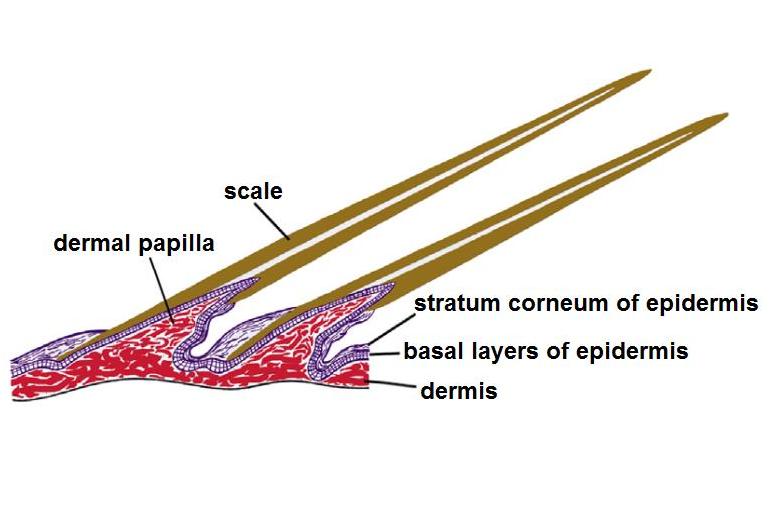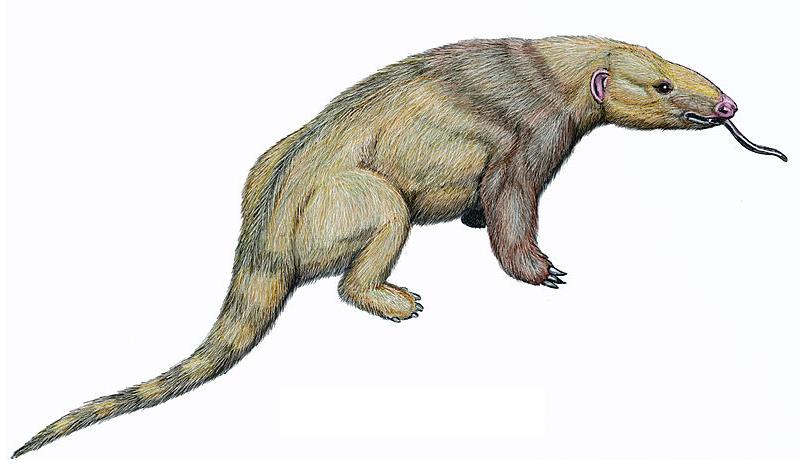|
Pholidotamorpha
Pholidotamorpha ("pangolin-shaped") is a clade of mammals that includes the orders Palaeanodonta and Pholidota (the pangolins). In the past both orders were formerly classified with various other orders of ant-eating mammals, most notably Xenarthra, which includes the true anteaters, sloths, and the armadillos which pangolins superficially resemble. Newer genetic evidence, however, indicates their closest living relatives are the Carnivora with which they form the clade Ferae. Some palaeontologists, placing family Ernanodontidae in a separate suborder Ernanodonta of Cimolesta near Pholidota, have classified the pangolins in the order Cimolesta, together with several extinct groups indicated (†) below, though this idea has fallen out of favor since it was determined that cimolestids were not placental mammals. A 2012 study from new remains found in Late Paleocene Mongolian strata have led to the assessment that '' Ernanodon'' is closely related to '' Metacheiromys'' within the ... [...More Info...] [...Related Items...] OR: [Wikipedia] [Google] [Baidu] |
Pholidota
Pangolins, sometimes known as scaly anteaters, are mammals of the order Pholidota (, from Ancient Greek ϕολιδωτός – "clad in scales"). The one extant family, the Manidae, has three genera: ''Manis'', ''Phataginus'', and ''Smutsia''. ''Manis'' comprises the four species found in Asia, while ''Phataginus'' and ''Smutsia'' include two species each, all found in sub-Saharan Africa. These species range in size from . A number of extinct pangolin species are also known. Pangolins have large, protective keratin scales, similar in material to fingernails and toenails, covering their skin; they are the only known mammals with this feature. They live in hollow trees or burrows, depending on the species. Pangolins are nocturnal, and their diet consists of mainly ants and termites, which they capture using their long tongues. They tend to be solitary animals, meeting only to mate and produce a litter of one to three offspring, which they raise for about two years. Pangolins ar ... [...More Info...] [...Related Items...] OR: [Wikipedia] [Google] [Baidu] |
Pangolin
Pangolins, sometimes known as scaly anteaters, are mammals of the order Pholidota (, from Ancient Greek ϕολιδωτός – "clad in scales"). The one extant family, the Manidae, has three genera: '' Manis'', ''Phataginus'', and '' Smutsia''. ''Manis'' comprises the four species found in Asia, while ''Phataginus'' and ''Smutsia'' include two species each, all found in sub-Saharan Africa. These species range in size from . A number of extinct pangolin species are also known. Pangolins have large, protective keratin scales, similar in material to fingernails and toenails, covering their skin; they are the only known mammals with this feature. They live in hollow trees or burrows, depending on the species. Pangolins are nocturnal, and their diet consists of mainly ants and termites, which they capture using their long tongues. They tend to be solitary animals, meeting only to mate and produce a litter of one to three offspring, which they raise for about two years. Pangoli ... [...More Info...] [...Related Items...] OR: [Wikipedia] [Google] [Baidu] |
Pan-Carnivora
Ferae ( , , "wild beasts") is a mirorder of placental mammalsMalcolm C. McKenna, Susan K. Bell: ''Classification of Mammals: Above the Species Level'' in Columbia University Press, New York (1997), 631 Seiten. that groups together clades Pan-Carnivora and Pholidotamorpha. The Ferae is a sister group to the clade Pan-Euungulata and together they make grandorder Ferungulata. Classification and phylogeny Taxonomy : Phylogeny The phylogenetic relationships of mirorder Ferae are shown in the following cladogram, reconstructed from mitochondrial and nuclear DNA and protein characters, as well as the fossil record.O’Leary, M. A., Bloch JI, Flynn, J. J., Gaudin, T. J., Giallombardo, A., Giannini, N. P., Goldber, S. L, Kraatz, B. P., Luo, Z-X, Jin Meng, Xijun Ni, Novacek, M. J., Perini, F. A., Randall, Z. S., Rougier, G. W., Sargis, E. J., Silcox, M. T., Simmons, N. B., Spaulding, M. Velazco, P. M., Weksler, M., Wible, J. R. Cirranello, A. L. (2013."The Placental Mammal Ancestor an ... [...More Info...] [...Related Items...] OR: [Wikipedia] [Google] [Baidu] |
Ferae
Ferae ( , , "wild beasts") is a mirorder of placental mammalsMalcolm C. McKenna, Susan K. Bell: ''Classification of Mammals: Above the Species Level'' in Columbia University Press, New York (1997), 631 Seiten. that groups together clades Pan-Carnivora and Pholidotamorpha. The Ferae is a sister group to the clade Pan-Euungulata and together they make grandorder Ferungulata. Classification and phylogeny Taxonomy : Phylogeny The phylogenetic relationships of mirorder Ferae are shown in the following cladogram, reconstructed from mitochondrial and nuclear DNA and protein characters, as well as the fossil record.O’Leary, M. A., Bloch JI, Flynn, J. J., Gaudin, T. J., Giallombardo, A., Giannini, N. P., Goldber, S. L, Kraatz, B. P., Luo, Z-X, Jin Meng, Xijun Ni, Novacek, M. J., Perini, F. A., Randall, Z. S., Rougier, G. W., Sargis, E. J., Silcox, M. T., Simmons, N. B., Spaulding, M. Velazco, P. M., Weksler, M., Wible, J. R. Cirranello, A. L. (2013."The Placental Mammal Ancestor ... [...More Info...] [...Related Items...] OR: [Wikipedia] [Google] [Baidu] |
Ernanodontidae
Ernanodontidae ("sprouts of toothless animals") is an extinct family of insectivorous stem-pangolins which were endemic to Asia from the middle Paleocene to the early Eocene The Eocene ( ) Epoch is a geological epoch that lasted from about 56 to 33.9 million years ago (mya). It is the second epoch of the Paleogene Period in the modern Cenozoic Era. The name ''Eocene'' comes from the Ancient Greek (''ēṓs'', " ..., 62.22—55.8 Ma existing for approximately . Classification and phylogeny Classification * Family: †Ernanodontidae (Ting, 1979)Malcolm C. McKenna, Susan K. Bell: ''Classification of Mammals: Above the Species Level'' in Columbia University Press, New York (1997), 631 Seiten. ** Genus: †'' Asiabradypus'' (Nessov, 1987) *** †''Asiabradypus incompositus'' (Nessov, 1987)L. A. Nessov. (1987). ''"Rezultaty poiskov i issledovaniya Melovykh i Rannepaleogenovykh mlekopitayushikh na territorii SSSR esults of searches and investigations of Cretaceous and early ... [...More Info...] [...Related Items...] OR: [Wikipedia] [Google] [Baidu] |
Eupholidota
Eupholidota ("true pangolins") is a suborder of pangolins that includes two superfamilies: extant Manoidea and extinct Eomanoidea. Taxonomy * Suborder: Eupholidota (true pangolins) ** Superfamily: Manoidea *** Family: Manidae (pangolins) *** Family: † Patriomanidae *** '' Incertae sedis'' **** Genus: †''Necromanis ''Necromanis'' ("extinct pangolin") is an extinct genus of pangolin from superfamily Manoidea. It lived during the Oligocene and Miocene of Europe. It was originally placed within family Manidae, but was eventually removed from it as more fo ...'' ** Superfamily: † Eomanoidea *** Family: † Eomanidae Phylogeny Phylogenetic position of suborder Eupholidota within order Pholidota. References Pangolins {{mammal-stub ... [...More Info...] [...Related Items...] OR: [Wikipedia] [Google] [Baidu] |
Euromanis
''Euromanis'' ("european pangolin") is one of the earliest known pangolin genera. It lived during the Eocene in Europe. ''Euromanis'' fossils found in the Messel Pit in Germany Germany,, officially the Federal Republic of Germany, is a country in Central Europe. It is the second most populous country in Europe after Russia, and the most populous member state of the European Union. Germany is situated betwee .... Unlike modern pangolins, it did not bear scales on its body. Phylogeny Phylogenetic position of genus ''Euromanis'' within order Pholidota. References Prehistoric pangolins Eocene mammals Myrmecophagous mammals Prehistoric placental genera Cenozoic mammals of Europe Fossil taxa described in 1994 {{paleo-mammal-stub ... [...More Info...] [...Related Items...] OR: [Wikipedia] [Google] [Baidu] |
Manis
''Manis'' is a genus of South Asian and East Asian pangolins, the Asiatic pangolins, from subfamily Maninae, within family Manidae. Etymology Carl Linnaeus (1758) invented the Neo-Latin generic name ''Manis'' apparently as a feminine singular form of the Latin masculine plural Manes, the Ancient Roman name for a type of spirit, after the animal's strange appearance. Taxonomy * Subfamily: Maninae (Asiatic pangolins) ** Genus: ''Manis'' (Asiatic pangolins) *** ''Manis crassicaudata'' (Indian pangolin) *** '' Manis pentadactyla'' (Chinese pangolin) *** ''Manis'' sp. (Scale_H4 & Scale_H8)Huarong Zhang, Mark P. Miller, Feng Yang, Hon Ki Chan, Philippe Gaubert, Gary Ades, Gunter A. Fischer (2015."Molecular tracing of confiscated pangolin scales for conservation and illegal trade monitoring in Southeast Asia" Global Ecology and Conservation, Volume 4, Pages 414-422Jingyang Hu, Christian Roos, Xue Lv, Weimin Kuang, Li Yu (2020."Molecular Genetics Supports a Potential Fifth Asian Pan ... [...More Info...] [...Related Items...] OR: [Wikipedia] [Google] [Baidu] |
Escavadodon
''Escavadodon'' ("tooth from Escavada") is an extinct genus of pangolin-like insectivorous mammal which was endemic to North America during the Early Paleocene ( Torrejonian in the NALMA classification), from approximately 63.8 to 60.9 Ma, existing for approximately . It contains a single species, ''Escavadodon zygus''. Taxonomy The monotypic family Escavadodontidae was erected by Rose and Lucas in 2000 to hold the type species, recovered from the Nacimiento Formation of New Mexico ) , population_demonym = New Mexican ( es, Neomexicano, Neomejicano, Nuevo Mexicano) , seat = Santa Fe , LargestCity = Albuquerque , LargestMetro = Tiguex , OfficialLang = None , Languages = English, Spanish ( New Mexican), Navajo, Ke .... Phylogenetic tree The phylogenetic relationships of genus ''Escavadodon'' is shown in the following cladogram: References Palaeanodonta Paleocene mammals of North America Torrejonian Fossils of the United States Paleontology in N ... [...More Info...] [...Related Items...] OR: [Wikipedia] [Google] [Baidu] |
Epoicotheriidae
Epoicotheriidae ("strange beasts") is an extinct family of insectivorous mammals which were endemic to North America from the early Eocene to the early Oligocene 55.8—30.9 Ma existing for approximately . Epoicotheriids were highly specialized animals that were convergent with the golden moles Golden moles are small insectivorous burrowing mammals endemic to Sub-Saharan Africa. They comprise the family Chrysochloridae and as such they are taxonomically distinct from the true moles, family Talpidae, and other mole-like families, a ... of Africa in the structure of their skulls and forelimbs, and would have had a similar lifestyle as subterranean burrowers.Kenneth D. Rose, Robert J. Emry (1983"Extraordinary fossorial adaptations in the oligocene palaeanodonts ''Epoicotherium'' and ''Xenocranium'' (Mammalia)"Journal of Morphology 175(1):33 - 56 Classification and phylogeny Taxonomy Epoicotheriidae was named by Simpson in 1927. It was assigned to the Palaeanodonta by Ros ... [...More Info...] [...Related Items...] OR: [Wikipedia] [Google] [Baidu] |
Palaeanodonta
Palaeanodonta ("ancient toothless animals") is an extinct clade of stem- pangolins. They were insectivorous, possibly fossorial, and lived from the Early Paleocene to Early Oligocene in North America, Europe and East Asia. While the taxonomic grouping of Palaeanodonta has been debated,Averianov, A. O. & Lopatin, A. V. (2014."High-level systematics of placental mammals: Current status of the problem."Biology Bulletin, 41(9), 801–816. it is widely thought that they are a sister group to pangolins. Anatomy Skull Palaeanodonts generally have low and caudally-broad skulls, with notable lambdoid crests and inflated bullae and squamosals. Teeth Despite the name of the group and contrary to their pangolin relatives, palaeanodonts are known to have had teeth. Early palaeanodonts retained minimal tribosphenic post-canines while later species had peglike or otherwise reduced molar crowns. Many also had large, characteristic cuspids. Classification and phylogeny Traditi ... [...More Info...] [...Related Items...] OR: [Wikipedia] [Google] [Baidu] |
Eomanis
''Eomanis'' ("dawn pangolin") is the earliest known true (and scaled) pangolin from extinct family Eomanidae (and extinct superfamily Eomanoidea) within suborder Eupholidota. It lived during the Eocene in Europe. ''Eomanis'' fossils found in the Messel Pit in Germany are very similar in size and anatomy to living pangolins of the genus ''Manis'', indicating that pangolins have remained largely unchanged in morphology and behavior for 50 million years. However, unlike modern pangolins, its tail and legs did not bear scales. According to the stomach contents of the excellently preserved Messel specimens, ''Eomanis’'' diet consisted of both insects and plants. Another early mammal discovered in the Messel Pit that was similar in anatomy and likely also had an insectivorous diet was ''Eurotamandua''. Despite its name, ''Eurotamandua'' was almost certainly not a xenarthran because it lacked the characteristic xenarthran joints present in all living and extinct xenarthrans. In additi ... [...More Info...] [...Related Items...] OR: [Wikipedia] [Google] [Baidu] |
.jpg)

.jpg)
